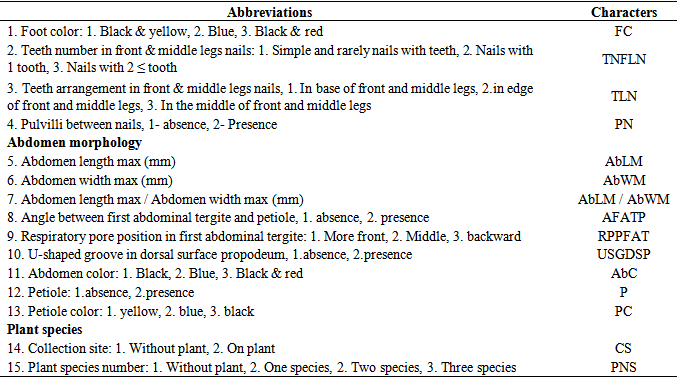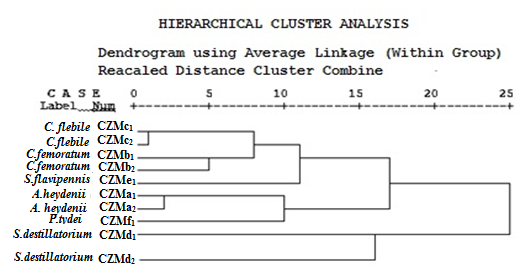-
Paper Information
- Previous Paper
- Paper Submission
-
Journal Information
- About This Journal
- Editorial Board
- Current Issue
- Archive
- Author Guidelines
- Contact Us
Research in Zoology
p-ISSN: 2325-002X e-ISSN: 2325-0038
2014; 4(1): 20-28
doi:10.5923/j.zoology.20140401.04
Biosystematic Study of Sphecidae Family in Golpayegan-Isfahan Province, Iran
Alireza Shayestehfar1, Mitra Noori1, Mahdi Talebi1, Zahra Moniri2
1Department of Biology, Faculty of Science, Arak University, 38156-8-8349, Arak-Iran
2MSc student of Animal Biosystematics, Department of Biology, Faculty of Science, Arak University, 38156-8-8349, Arak-Iran
Correspondence to: Mitra Noori, Department of Biology, Faculty of Science, Arak University, 38156-8-8349, Arak-Iran.
| Email: |  |
Copyright © 2014 Scientific & Academic Publishing. All Rights Reserved.
The Sphecidae (Latreille, 1802) family (braided waist or digger wasps) from Hymenoptera consist of 4 subfamilies, 20 genera and about 660 species in the world. The family members are different in size (from 1.8-30 mm) wasps with distinct abdominal petiole in various color. They have important role as pollinator, plant pests, predator and parasitic in natural environments. 67 species of this family has been reported from Iran. The bees have a wide distribution almost in arid and semi arid areas of world. They have wide distribution in different habitats of Iran and almost live in pastures and arid regions. Since it is not always possible to classify animal using just morphological characters, so, in this research a new systematic approach was used by utilizing ecology, morpho-anatomy, biological interactions for more accurate taxonomy and biological fauna of the family members. In this research 6 species of this family (Ammophila heydenii Dahlbom 1845, Chalybion femoratum Fabricius 1782, Chalybion flebile Lepeletier de saint-fargeau, 1845, Sceliphron destillatorium Illiger 1807, Sphex flavipennis Fabricius 1793, Podalonia tydei Guillou 1841) reported from Golpayegan, Isfahan Province for first time. 10 Populations of 6 species of Sphecidae family were collected from different parts of Golpayegan and identified by using available references. 36 qualitative and quantitative morpho-biometrical characters were identified and studied using suitable equipments. Data were coded and analyzed by principal component analysis (PCA) test using the SPSS. Then cluster were performed. Statistical analysis of morpho-biometrical data showed that U-shaped groove in dorsal surface propodeum, Antenna color, second sub marginal cell length of front wing to basal veinlet (basal veinlet/anterior veinlet), return veins connection to sub marginal cells of front wing, teeth number in front and middle legs nails, teeth arrangement in front and middle legs nails, pulvilli between nails, foot color and angle between first abdominal tergite and petiole are more valuable tools comparing with other characters for differentiating the species.
Keywords: Sphecidae, Ammophilinae, Sphecinae, Sceliphrinae, Iran, Isfahan Province, Golpayegan
Cite this paper: Alireza Shayestehfar, Mitra Noori, Mahdi Talebi, Zahra Moniri, Biosystematic Study of Sphecidae Family in Golpayegan-Isfahan Province, Iran, Research in Zoology , Vol. 4 No. 1, 2014, pp. 20-28. doi: 10.5923/j.zoology.20140401.04.
Article Outline
1. Introduction
- Sphecidae (mud-dauber and thread-waisted wasps or digger wasps) (Latreille 1802) is a cosmopolitan family of wasps. Traditionally, all sphecid wasps were included in a single family, Sphecidae. The traditional classification of Sphecid wasps changed with the advent of cladistics. Cladistics showed this group to be paraphiletic. Bees are closely related to sphecids now forming the family Crabronidae. Sphecidae s. str., Ampulicidae and Heterogynaidae are sister groups to bees and Crabronidae combined [1]. Both conservative definition of the Sphecidae where all the sphecid wasps are treated in a single large family and the more refined one, where the sphecid subfamilies were each elevated to family rank have recently been shown to be paraphyletic. Most specialists have considered the Sphecidae as a natural group, either as a family [2] or as a superfamily [3]. However, some specialists consider the Sphecidae to be a paraphyletic group [4], and this has been confirmed more recently by Alexander (1992) and Melo (1999) [5 & 6]. The latter specialist believes that the Sphecidae is in fact three families: Ampulicidae, Sphecidae and Crabronidae, which, together with the bees and the Heterogynaidae, form the superfamily Apoidea. This opinion was discussed by Brothers (1999) [7]. To refer to the three families proposed by Melo (1999) [8], the term Spheciformes has been used, a denomination already proposed by Brothers (1975 [7]. Based on some phylogenetic studies, the former family Sphecidae is now divided into four families: Heterogynaidae, Ampulicidae, Crabronidae and Sphecidae [Prentice 1998, unpublished doctoral thesis; 7 & 8]. Prentice, Brothers, and Melo independently subdivided the extant Apoidea into five monophyletic families: Heterogynaidae, Ampulicidae, Sphecidae, Apidae, and Crabronidae [1]. Currently there are 9660 described species in three subfamilies: Ammophilinae, Sceliphrinae, and Sphecinae distributed throughout the world [9]. The family Sphecidae contains a vast array of genera and species that, collectively, are exceedingly diverse morphologically, ecologically and behaviorally [3, 10, 11]. They are worldwide in distribution, mainly occupying arid and semi arid areas, but are most numerous in warm and more or less dry habitats. While adult wasps feed on flowers, females hunt insects or spiders to provision their progeny. They are mostly specialized hunters of specific insect prey, but many species prey on a wide array of spiders. Females nest in the ground, in wood borings or plant stems, and some build exposed mud nests attached to stones or wood. A few genera consist of cleptoparasitic species. Most are active in summer months [9].Up to now 65 species of the family have been reported from Iran by in-country authors [12, 13, 14, 15, 16, 17, 18, 19,]. Meanwhile many European and other specialists have had contributions on Iranian sphecids [20]. About 102 species in 11 genera occur in North America, including 34 species in 10 genera in Canada [21]. Also Menke (1996) studied on family Sphecidae (Sphecinae) in Costa Rica. He recorded three genera (Ammophila Kirby, Eremmophila Menke and Podalonia Fernald) and nine species of Ammophilini from Costa Rica. Then a key and illustration provided for their identification [22]. Shalan-Augul et al (2013) after collecting 409 specimens of Ammophilini tribe (Hymenoptera: Sphecidae: Sphecinae) from different region of Iraq, thirteen species belonging to four genera were determined. They recorded genus of Parapsammophila and six species (Ammophila barbara, A. sabulosa, A. gracillima, A. hungarica, Podalonia minax and Parapsammophila turanica as new records to the Iraqi fauna and also gave an identification keys to the subfamily, tribes, genera and species [23, 24].Recent estimates indicate the presence of about 300 of the 9720 species occurring in the Arabian Peninsula (Ohl, own observation in Schmid-Egger 2011) [25]. The majority of the species nest in soil but certain taxa inhabit living or dead plant materiaL A few genera, such as Sceliphron, are muddaubers. Species of Sphecidae prey upon a tremendous variety of terrestrial insects and spiders, with host specificity ranging from absolute species-specificity to capturing several orders of insects. Some sphecids are large, showy and highly noticeable, even to a layman's eye, while others are small, obscure and rarely seen (Krombein 1979) [3].Sphecidae use a vast of insects and arachnids to feed their larvae, although prey selection is usually limited to members of a single family or order. Prey is immobilized by the female wasps by stinging and then brought in to the nest (some species are nest parasites, i.e., they enter nests of other sphecid species and oviposit on the prey there).most species dig burrows actively in the ground for nesting or establish their nests in dead wood or in twigs, but some use preexisting cavities and other build nest out of mud because of their habits, sphecidae play an important role in their ecosystems [26].Sphecidae is a diverse group of solitary wasps which may be of different shaped , size and color ;the female digs it nest in sand, soil or wood and provisions each nest cell with paralyzed prey and lays a single on it. The wasps larva feeds on the provisions, adults feed on nectar, pollen and juices containing high amount of sugar while the larvae need adults or larvae of different insect orders and Araneida [2, 27, 28]. The Sphecinae wasps can be recognize by many diagnostic characters such as; gaster with cylindrical elongate petiole composed of sternum only unless it has two section as in Ammophila Kirby, inner orbits of eyes without notch, mandibles without a notch on externo-ventral margin, notauli on scutum absent but weak and short when present, jugal lobe of hind wing large containing an anal vein, no pygidial plate, male with 13 and female with 12 antennal segments [21, 29]. They are generally black-bodied insects or black marked with white, yellow or red; some are tinged with metallic blue or green. They range in size from about 2mm up to 51 mm long [25]. In this study 36 qualitative and quantitative morpho-biometrical characters of six species of the family from Iran (Golpaygan-Isfahan Province) were identified. Then obtained data were coded and analyzed by principal component analysis (PCA) test. Then cluster were performed.
2. Materials and Methods
- The adult wasps were collected by arial net, through June and July 2013 from Golpayegan region, Isfahan Province, Iran. Then all collected Sphecidae samples were prepared, mounted and then identified using available references [2, 13]. Also our identifications were confirmed by Prof. Pulawski, Gadallah, Schmid Egger and Augul. Voucher specimens were deposited at Natural History Musium of Arak University and their locality and collecting date were provided on the labels (Table 1). 26 quantitative and 15 qualitative morpho-biometrical characters were identified and studied using suitable equipments (Table 2 & 3). All of quantitative and qualitative morpho-biometerical data (Table 4) analyzed by principal component analysis (PCA) test using the SPSS (Tables 5 & 6). Then cluster were performed. Fit of the clusters to the original data was checked using cophenetic correlation (Figure 1). Finally a key based on the studied sphecideae characters was prepared (Table 7).
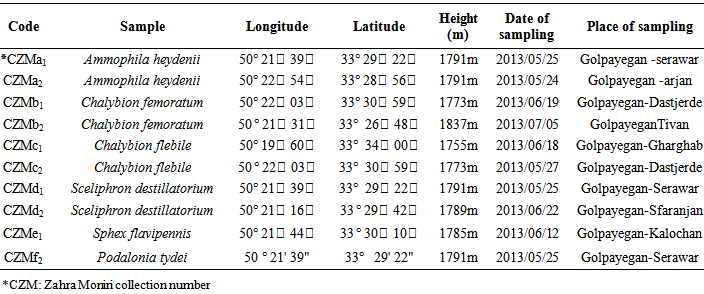 | Table 1. Collection information of 10 collected Populations of Sphecidae family from different parts of Golpayegan-Isfahan Province, Iran |
|
|
 | Table 4. Quantitative morpho-biometerical characters data of studied Sphecidae populations from Golpayegan-Isfahan Province, Iran |
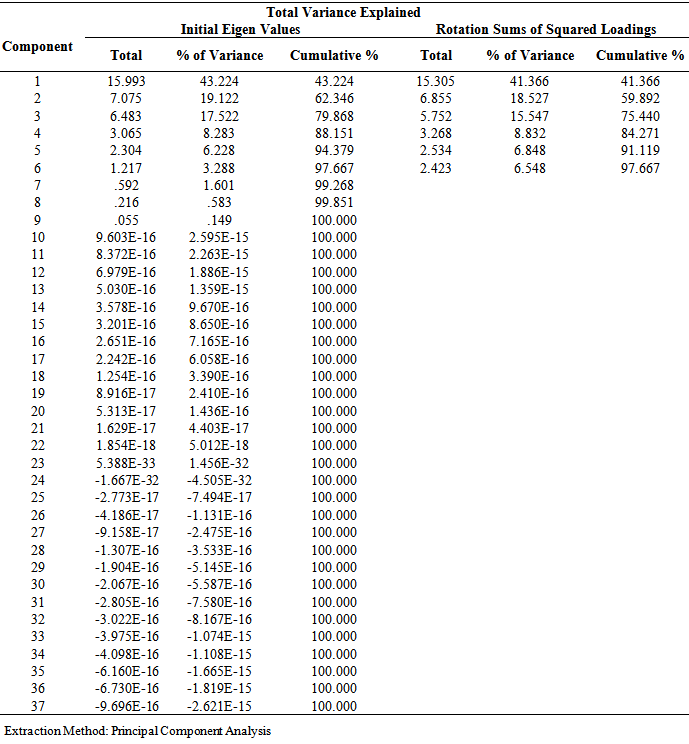 | Table 5. Total variance explained for principal component analysis for studied Sphecidae populations characters |
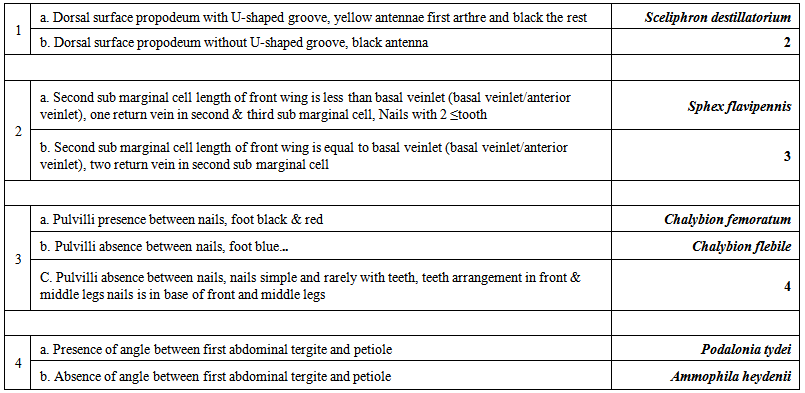 | Table 7. Sphecidae identification key based on morpho-biometerical characters of studied taxa in Golpayegan-Isfahan Province, Iran |
3. Results
- Collection information of 10 collected Populations of Sphecidae family from different parts of Golpayegan- Isfahan Province, Iran have shown in Table 1. Table 4 shows quantitative morpho-biometerical characters data (M ± SD) of studied Sphecidae populations. Total variance explained for principal component analysis for studied Sphecidae population characters has been showed in Table 5. Table 6 shows six components of PCA test and correlating quantitative and qualitative morpho-biometerical characters of studied Sphecidae taxa (P<0.05). Analysing quantitative and qualitative morpho-biometerical characters using three different cluster analysing method showed the Within Group method provided the best data (Figure 1). Table 7 shows an identification key based on the studied Sphecidae characters.
4. Discussion and Conclusions
- Studies on Sphecidae morphological characters in Golpaygan -Isfahan Province, Iran showed many variations in some characters such as body length, head length and width max, head length max/head width max, antenna length and width max, antenna length max/antenna width max, antenna arthre number, thorax length and width max, thorax length max/thorax width max, wing length and width max, wing length max/wing width max, abdomen length and width max, abdomen length max/abdomen width max, foot length and width max and foot length/foot width max. Ebrahimi (1993a) and Ghazi Soltani et al (2006) used these characters for separation and identification Sphecidae genera [13, 19]. Studied qualitative characters data showed the wasps have high variation in Antenna color, Thorax Color, Return veins connection to sub marginal cells of front wing, Second sub marginal cell length of front wing to basal veinlet (basal veinle /anterior veinlet), Apex wing dark margin, Angle between first abdominal tergite and petiole, Respiratory pore position in first abdominal tergite, U-shaped groove in dorsal surface propodeum, Abdomen, Petiole and foot color, Teeth number in front & middle legs nails, Teeth arrangement in front & middle legs nails, Pulvilli between nails, collecting site and plant species number. Some researchers used these characters for Sphecidae taxa separation and identification [2, 22, 23, 24, 30].Factor analysis results of morpho-biometerical characters in Table 5 and 6 showed that the first six factors describe about 98% of total variance. First and second components with 41% total variation were found positively correlated with Thorax length max (TLM), U-shaped groove in dorsal surface propodeum (USGDSP), Wing length max (WLM), Foot length and width (FLM & FWM), antenna length and width max (ALM & AWM), abdomen and head width max (AbWM & HWM) and negatively correlated with antenna, foot, thorax, abdomen and petiole color (AC, FC, TC, AbC & PC), collection site (CS) and plant species number (PSN). Component 2 with 18% total variation was positive and significantly correlated with abdomen length max (AbLM) and abdomen length max/abdomen width max (AbLM/AbWM) and negatively correlated with apex wing dark margin (AWDM), pulvilli between nails (PN) and Teeth arrangement in front & middle legs nails (TLN). Component 3 with 16% total variation was correlated positively and significantly with Head length max/Head width max (HLM/HWM) and negatively correlated with return veins connection to sub marginal cells of front wing (RVCSCFW) and second sub marginal cell length of front wing to basal veinlet (basal veinlet/anterior veinlet (SSCLFW). Two last components 5 and 6 with 7% total variation were positively correlated with antenna arthre number (AAN) and negatively correlated with wing length max/wing width max (WLM/WWM) (≥ 0.7 coefficient). In Figure 1 cluster analysis of morpho-biometerical characters data using cophenetic correlation showed two main clades: first clade consist of 2 sub-clade that first sub-clade contained 5 taxa and the second sub-clade have 3 taxa. Second clade consist of 2 populations of Sceliphron destillatorium species. As Figure 1 shows all of studied populations with the exception of Sceliphron destillatorium (CZMd1 & CZMd2) are in one clade that 4 populations of Chalybion genus (CZMc1, CZMc2, CZMb1 and CZMb2) are in 1 sub-clade. Finally study of 10 Sphecidae species using morpho-biometerical characters showed Dorsal surface propodeum with or without U-shaped groove, antenna and foot color, basal veinlet/anterior veinlet, pulvilli presence or absence between nails, nail characters and presence or absence of angle between first abdominal tergite and petiole are the most valuable and representative characters for separation of Sphecidae taxa. We know morphology was for a long time the only discipline contributing the characters for systematics and phylogenetic reconstruction [31]. Also morphometrics is used most often to seek patterns of relationship at lower levels in the taxonomic hierarchy, where mosaic patterns make intuitive pattern recognition difficult, if not possible, and in which concepts of holophyly are inappropriate [32]. Therefore study of morpho-biometerical characters are useful in distinguishing among extant genera of Sphecidae and species identification. Based on this study results an identification key was prepared (Table 7).
ACKNOWLEDGEMENTS
- The authors would like to thank of Prof. Wojciech J. Pulawski, Prof. Neveen S. Gadallah and Dr. Christian Schmid-Egger for their helps in determination and confirmation of our samples.
References
| [1] | PULAWSKI WJ. 2009. Catalog of sphecidae. available on:www.calacademy.org. |
| [2] | BOHART RM & MENKE AS. 1976. Sphecidae wasps of the world: a generic revision. Berkeley: University of California press. p. 665. |
| [3] | KROMBEIN KV. 1979. Superfamily sphecoidea, pp. 1573-1740. In: KROMBEIN KV, HURD PD, SMITH JRDR & BURKS BD. Catalog of hymenoptera in america north of mexico. vol. 2, apocrita (aculeata), Smithsonian Inst. Press, Washington, D.C. |
| [4] | BROTHERS DJ. 1975. Phylogeny and classification of the aculeate hymenoptera, with special reference to mutillidae. The University of Kansas Science Bulletin, 50: 483-648. |
| [5] | ALEXANDER BA. 1992. A cladistic analysis of the subfamily philanthinae (hymenoptera: sphecidae). Systematic Entomology, 17: 91-108. |
| [6] | MELO GAR. 1999a. Two new genera of pemphredonine wasps from Australia (hymenoptera: apoidea: crabronidae) Special Publication. the University of Kansas . Natural History Museum, 24: 221-229. |
| [7] | BROTHERS DJ. 1999. Phylogeny and evolution of wasps, ants and bees (hymenoptera, chrysidoidea, vespoidea and apoidea). Zoologica Scripta, 28: 233-249. |
| [8] | MELO GAR. 1999b. Phylogenetic relationships and classification of the major lineages of apoidea (hymenoptera), with emphasis on the crabronid wasps. scientific papers, Natural History Museum, University of Kansas, 14: 1-55. |
| [9] | PULAWSKI WJ. 2003-2011. Catalog of sphecidae sensu lato (= apoidea excluding apidae).http://research.calacademy.org/ent/catalog_sphecidae. |
| [10] | EVANS HE. 1963. Predatory wasps. Sci. Amer., 208: 145-154. |
| [11] | EVANS HE. 1966. The behavior patterns of solitary wasps. Ann. Rev. Entomol, 11: 123-154. |
| [12] | ESMAILI M & RASTEGAR R. 1974. Identified species of aculeate hymenoptera of Iran. Journal of Entomological Society of Iran 2 (1): 41-52. |
| [13] | EBRAHIMI E. 1993a. The sphecid wasps of subfamily sphecidae in Iran (hymenoptera: sphecidae). Journal of Entomological Society of Iran, 12 and 13: 87-104. |
| [14] | EBRAHIMI E. 1993b. Introduction of pemphredon lethifera and its biological study in Iran. Proceedings of 11th Iranian Plant Protection Congress, 250. |
| [15] | EBRAHIMI E. 2000a. The first report on three orthopteran predator wasps in Iran. Proceedings of 14th Iranian Plant Protection Congress, vol. I, Pests, 361. |
| [16] | EBRAHIMI E. 2000b. The first record of three predator wasps in Iran. Proceedings of 14th Iranian Plant Protection Congress, vol. I, Pests, 362. |
| [17] | EBRAHIMI E. 2005. An identification guide to the sphecidae of Iran (insecta, hymenoptera). Journal of Entomological Society of Iran 24(2), 109-135. |
| [18] | EBRAHIMI E, KHARAZIPAKDEL A & ESMAILI M. 1995. The first record of four aphid predator wasps in iran. Proceedings of 12th Iranian Plant Protection Congress, 290. |
| [19] | GHAZI-SOLTANI G, EBRAHIMI E. & IRANIPUR S. 2006. A new record of a crabronid wasp hym.: sphecidae) for iran from East Azarbaijan Province III th European Congress of Entomology, Izmir, Turkey, Supplementary Abstract Book 2, RVPP-08. |
| [20] | EBRAHIMI E. 2008. A contribution to the sphecid wasps of Iran (hymenoptera: sphecidae) including first record of six species, Journal of Entomological Society of Iran, 28 (1): 93-97. |
| [21] | GOULET H & HUBER JT. 1993. Hymenoptera of the world: an identification guide to families. Ottawa:Agriculture Canada, 668 pp. |
| [22] | MENKE AS. 1996. The ammophilini of costa rica; an identification guide (hymenoptera: sphecidae; sphecinae), J. Hym. Res, 5: 190-202. |
| [23] | SHALAN-AUGUL R. 2013. A new species of the genus sphex linnaeus, 1850 (hymenoptera: sphecidae; sphecinae) from Iraq, International Journal of Advanced Research, 1 (5): 475-484. |
| [24] | SHALAN-AUGUL R, ABDUL-RASSOUL MS & KHADDOU IK. 2013. A new species of ammophila kirby, 1798 with identification key to species of ammophilini (hymenoptera: sphecidae: sphecinae) in Iraq, Advances in Bioresearch, 4 (1): 12-27. |
| [25] | SCHMID-EGGER C. 2011. Order hymenoptera, families crabronidae and sphecidae, Arthropod Fauna of the Uae, 4: 488-608. |
| [26] | SEYOUM E & PULAWSKI WJ. 2001. Sphecid wasps (hymenoptera:apoidea:sphecidae) as potential control agent of acridid pests(orthoptera:acrididae) in Ethiopia, The Harwood Academic Publishers Imprint, 34: 319-326. |
| [27] | MURRAY WD. 1940. Podalonia of north and central america. Entomologica Americana: 31: 1-82. |
| [28] | GILLOTT C. 2005. Entomology. 3rd edition, published by springer, Netherlands, 831pp |
| [29] | BORROR DJ & DELONG DM. 1964. An introduction to the study of insects. hott, Rinehart and Wilston Inc. Revised Edition, 819 pp |
| [30] | GADALLAH NS & ASSERY BM. 2004. A review of the sphecidae (with the exception of larrinae) of the jeddah region (west of saudi arabia), with a checklist of the species known from saudi arabia–linzer Biologische Beitrage, 36: 215-239. |
| [31] | STUESSY TF, MAYER V & HORANDLE E. 2003. Deep morphology, a. r. g. gantner verlage k. g., Ruggell, Liechtenstein. |
| [32] | JENSEN RJ, SCHWOYER M, CRAWFORD DJ, STUESSY TF, ANDERSON GJ, BAEZA CM, SILVA OM & RUIZ E. 2002. Patterns of morphological and genetic variation among populations of myrceugenia fernandeziana (myrtaceae) in masatierra island: implications for conservation, Syst. Bot., 27: 534-547. |
 Abstract
Abstract Reference
Reference Full-Text PDF
Full-Text PDF Full-text HTML
Full-text HTML
